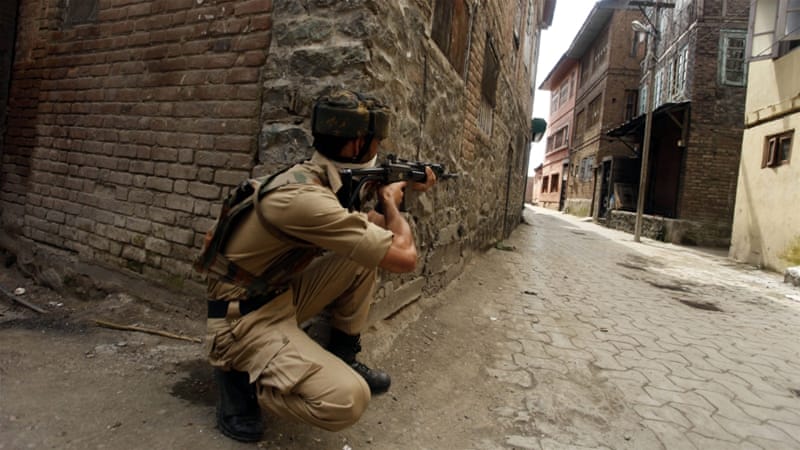
Srinagar, Indian-administered Kashmir - For Abdul Rehman Mir, the grief over the death of his son has turned to anger.
He is sitting on the living room floor of his small family home in the Tengpora neighbourhood of Kashmir's summer capital, Srinagar, surrounded by nearly 30 neighbours.
His son Shabir, 24, was killed by police on July 10 - two days into the mass protests against the Indian security forces' killing of Kashmiri rebel commander Burhan Wani.
His neighbours urge him to speak but the 48-year-old is reluctant. "What good will it do to talk about what happened?" he asks. "I only want justice. Whatever happens after that, I don't care."
One of the neighbours, Mohammed Haneef, tries to placate him. "He was your son. Only you can know the intense pain you are going through," says 42-year-old Haneef. "Today it happened to your son, but tomorrow, it could happen to mine. We are with you."
Mir begins to open up, explaining how on the evening of July 10, his family was watching television and drinking tea after returning home from the nearby mosque. He heard shouting outside, he says. From an upstairs window, he witnessed police officers smashing the windows on the ground floor of the house. They broke in and fired tear gas, he says.
"I asked why they were firing tear gas on us. What have we done? We are inside our home. Aren't you Muslims [like us]?" he remembers.
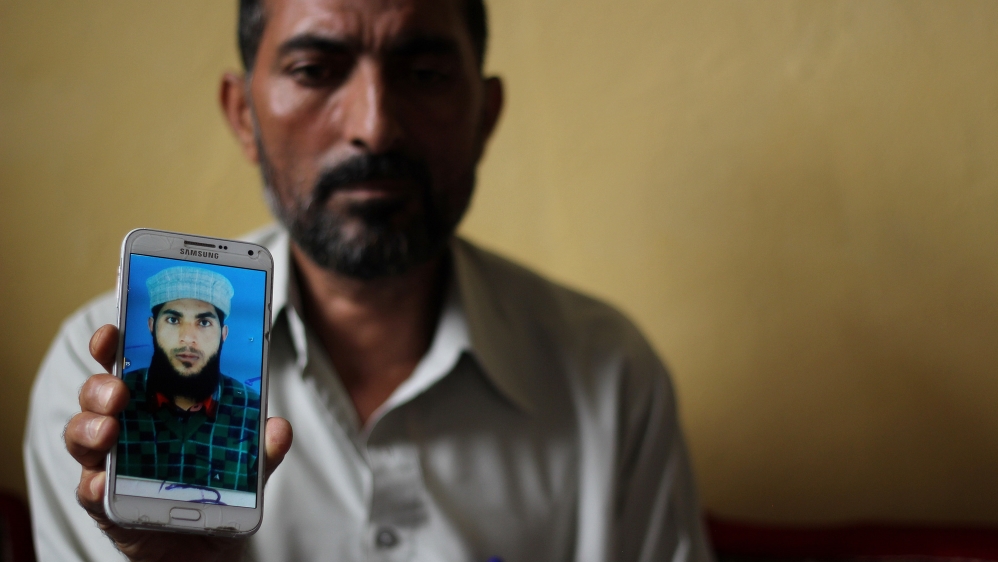 |
Mir's face was contorted with anger as he narrated the events that led to his son's death. He added that the police beat him and his wife, Shahazada Banu, 47. When Shabir tried to step in, "they shot him in his stomach in the corridor near the main door".
"My son tried to escape through the window, but security forces ran after him and fired a second shot in his stomach. He took a few steps and then fell down," he said with his eyes fixed on the wall.
"I held him in my arms. He died in my arms."
'There was no one like him'
Shabir was the second of Rehman and Shahazada's five children. As a tile mason, he was the family's breadwinner.
Rehman recalls how, after he suffered heart problems four years ago, Shabir had told him: "Father, you've done enough looking after us all our lives. It's time for you to rest now."
Neighbours remember Shabir as gentle and virtuous. "There was no one like him in our neighbourhood," says Shabir Ahmad Dar, 26. "He always walked with his head down. He never fought with anyone. He was a good man."
Local men gathered around said that on the evening of Shabir's death, there were no protests taking place outside Mir's house but some youth who had been protesting nearby had come to the area to take shelter from the security forces.
Shabir's body has now been exhumed and a post-mortem completed as part of the investigation. The results have not been made public yet.
Al Jazeera called the IGP, Syed Javaid Mujtaba Geelani, several times, but he refused to comment and hung up after saying, "I don't have time to talk to you right now." Repeated attempts by Al Jazeera to reach him over phone were unsuccessful.
Human rights activists say the security forces enjoy impunity from prosecution.
"The [successive] governments [India's federal government] have made it impossible for justice to be delivered," says Khurram Parvez, the programme coordinator of the Jammu and Kashmir Coalition of Civil Society (JKCCS).
"The violence that was perpetrated in Jammu and Kashmir and continues to be perpetrated today is institutional," adds Parvez, whose organisation documents human rights violations in the state and provides litigation for its victims.
In its report Structures of Violence, JKCCS documented 313 cases involving alleged abuses by 1,000 police and security force personnel between 1990 and 2015. None of those allegedly involved have been prosecuted, Parvez says.
The legend of Burhan Wani
Shabir is one of the 77 people, including seven security forces personnel, killed in the biggest anti-government protests in Kashmir in six years. They erupted after the killing of Burhan Wani, a 22-year-old rebel commander who had become a household name because of his use of social media.
Wani's story has become legend. He was a 15-year-old high school student with good grades when the security forces approached him and his brother Khalid. Although Khalid bought them cigarettes, as requested, they still allegedly beat him and broke his bike.
Wani stopped his studies and joined the armed group Hizbul Mujahideen, which wants the region to become part of Pakistan and is designated a terrorist organisation by India, the United States and the European Union.
Khalid was killed by the security forces last year allegedly for recruiting Kashmiris for Burhan, but his family says that he was tortured and killed for being the brother of a rebel leader.
Tens of thousands of mourners attended Wani's funeral and protesters poured onto the streets.
"Wani will recruit more people from his grave than when he was alive," says Umair Gul, who has been researching India's armed groups at Jamia Millia Islamia's Nelson Mandela Centre for Peace and Conflict Resolution in New Delhi.
His name is seen and heard all over Kashmir, in the graffiti that declares "Burhan Bhai [brother] Freedom Fighter" and "Burhan [is] still alive" and from the loudspeakers of mosques that blare songs extolling him.
Nineteen-year-old protester Umer explains: "Burhan Wani wasn't a terrorist. He was a freedom fighter."
"He was to us what your Gandhi was to you," Umer, who used one name for the fear of being identified, told Al Jazeera in the Nowhatta area of downtown Srinagar.
'Another country's propaganda'
Another protester from the same area, 19-year-old university student Faizan is one of about 20 boys and men throwing stones at the security forces. When asked why, he responds: "For freedom."
Boys as young as four join in; older men look on, smiling.
"There's no other solution," Faizan, who also uses one name for security reasons, says.
"They've been committing crimes against us since 1947. So many boys have been martyred, injured. These [security forces] are the supporters of the Indian government. They come to our mosques. They break our windows. They come into our homes when we're praying. They beat our mothers. They beat our sisters. We want to take our revenge against the Indian government.
Faizan's target is a group of about 20 Central Reserve Police Force (CRPF) paramilitary personnel standing a few hundred metres away with polycarbonate shields to protect them from the stones.
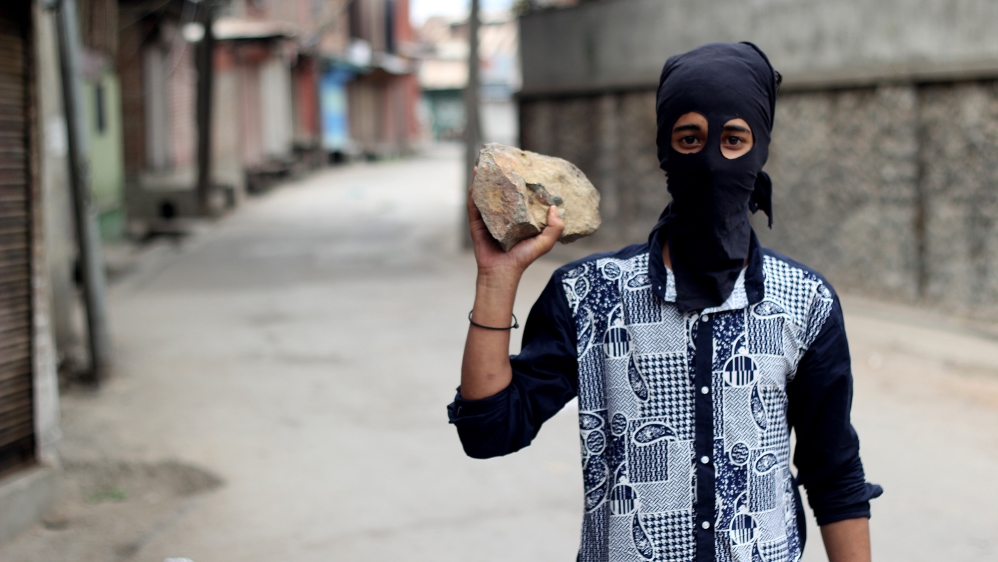 |
Sub-Inspector Hari Om says: "They don't understand the real situation. Those people who are calling out 'Pakistan' have forgotten history. Pakistan once attacked, then we came here to protect them and today, we are standing here to protect them."
The Sub-Inspector's words echo the mainstream Indian view of Kashmir's history and the current government line.
The Hindu nationalist Bharatiya Janata Party (BJP), which is in power in New Delhi, is part of the coalition government in Jammu and Kashmir for the first time in the state's history. It draws its support from the Hindu majority population of southern Jammu region of the state.
The BJP's Nirmal Singh is the state's deputy chief minister. "Pakistan has not accepted the reality that Jammu and Kashmir is an integral part of India," he tells Al Jazeera.
The Muslim-majority region has been divided between India and Pakistan, but claimed in full by both, since the two countries gained independence from Britain in 1947.
When asked how he feels about the graffiti that reads "Indian Dogs Go Back", Sub-Inspector Hari Om, in a soft-spoken manner, says: "This may be another country's propaganda to misguide people." He is referring to Pakistan.
"And even local politicians are imparting bad ideas to the children," he said as he nodded his head towards group of protesters. "Like in this group, a five-year-old is throwing stones, a three-year-old! What you are taught as a child, you can never forget, and yet, we think of these people as our own."
'An integral part'
The Indian government often refers to Kashmir as its 'atoot ang' - an unseverable limb or an integral part. Most Kashmiris seem to feel differently.
In his partially shuttered newspaper stand in central Srinagar's Lal Chowk area, 40-year-old Ahmed Mizgar says he has lost a lot of money since July 8.
"The Central government says you are an integral part, but it doesn't consider us their own people. It doesn't care about Kashmiris. It wants the land, not the people," he told Al Jazeera as he looked despondent.
Lal Chowk would usually be teeming with activity on a Sunday afternoon but the government imposed a strict curfew after Wani's killing to keep people off the streets.
The National Highway, which links the Kashmir Valley to the rest of India, has been closed. Phone and internet services have either been cut off or only work intermittently. Shops remain closed throughout the day.
On days when the curfew is eased, children come out to play on the streets; young boys ride bicycles; old men venture out to buy newspapers; groups of men play carom on the pavements, but they tell Al Jazeera that they do not want their photographs taken as that might give the impression that things are normal in Kashmir.
"They [the government] impose a curfew and say this is a law and order problem. It's not. It's a political dispute. They have to solve it politically. They have to talk to us, but they only kill and injure us," says Mizgar.
'What has he got to lose?'
At least 8,500 people have been injured in the unrest since July 9 - 5,000 by pellet guns that fire hundreds of tiny steel pellets per round.
Srinagar's Shri Maharaja Hari Singh (SMHS) Hospital is filled with victims. Nearly 500 people have been treated for serious eye injuries since the violence erupted.
Eighteen-year-old Mohammed lies motionless on a hospital bed in the casualty ward. His exposed torso is covered in small bloody holes, where pellets entered his body the day before. His gaze is fixed on the ceiling.
The medical report and X-rays by his bed show multiple pellets in his heart, lungs and stomach. Mohammed's cousin, 20-year-old Amir, says Mohammed was throwing stones at security forces during protests in the Imam Sahib village of Shopian district, when security forces retaliated by firing pellets.
Amir says Mohammed doesn't have the energy to speak. When asked if he will protest again, Amir answers for him. "What has he got to lose?" he says.
Like Mohammed, 18-year-old Mehraj was also throwing stones at security forces. His face is covered with pellet wounds. Both of his eyes are bruised and swollen.
None of the injured Al Jazeera spoke to wanted to reveal their full names for fear of being identified.
Doctors don't know whether he has lost the vision in his right eye, which is swollen shut. "If God wishes and my eye heals, I will protest again," Mehraj says.
The beds in the ophthalmology ward are filled with young men wearing sunglasses. Of the 5,000 people who have been injured by pellet guns, hundreds, including young children and bystanders, have been blinded.
Dr Yousef, 27, says the hospital has treated thousands of pellet injuries since July 8. "Most of them … are above the waist. They're on the chest or head, the eyes. They have specifically targeted the eyes," he explains.
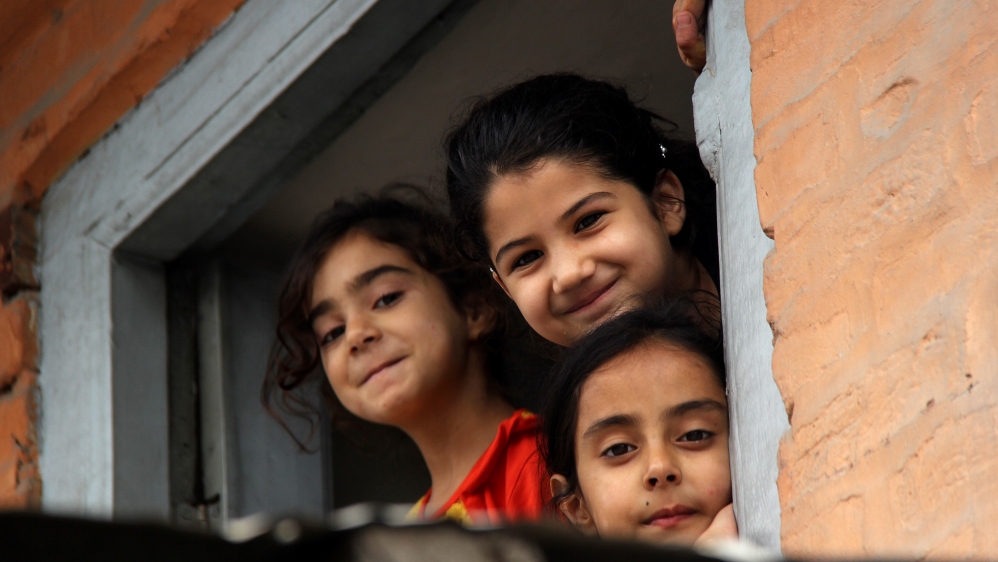 |
The CRPF spokesperson Rajesh Yadav says the paramilitary troops only use pellet guns when they absolutely have to. "Troops are not here to target innocent civilians. CRPF has maintained the highest level of restraint so far. If somebody's getting injured or there's a casualty, that is only when they are getting very close to the camp," he adds.
"They try to harm somebody physically. They're trying to snatch the weapons or setting the bunkers on fire. Only in these cases, pellets are being used."
Yadav says between 1,600 and 1,800 officers have been injured. But when asked if Al Jazeera could visit the injured officers, he says that won't be possible.
Dr Yousef, who didn't want his full name to be revealed, thinks the injuries won't deter protesters. "We have even got some patients whose guts are perforated and they are asking when they can go back and join the protests," he says.
Unlike Mohammed and Mehraj, who admit that they were throwing stones at the security forces, many patients say they were either protesting peacefully, were bystanders or, like the Mir family, were in their own homes when they were hit by pellets or bullets.
Fifteen-year-old Riyaz was shot in the chest during what, he says, was a peaceful protest march in Srinagar's Beerwah area.
He says the police had given his group permission to protest, but later opened fire on them. Eighty people were injured; two died. When asked if he'll protest again, Riyaz answers with those words so familiar in Kashmir: "Yes. We want freedom."
Al Jazeera tried to confirm the allegation with the security forces but they failed to provide details of the incident.
Beyond fear
Away from Srinagar, protests in Kashmir's southern districts, where most of the remaining rebels are based, are more violent. The town of Bijbehara in Anantnag district sits on the National Highway.
Protesters have built roadblocks with piles of heavy stones, tree trunks and barbed wire to keep the security forces and the media out. Hundreds of angry boys and men hurl rocks and abuse at a large contingent of army and police personnel.
The sound of tear gas canisters being fired pierces the air. The anger on both sides is palpable. One army officer grabs Al Jazeera's photographer by his collar and asks him to delete his photos. Another yells, "You're destroying India's reputation abroad by documenting what's going on."
Thirty-year-old shopkeeper Atif Hassan says he has been arrested or placed in preventative detention nearly 60 times since the 2008 protests against the Indian government's decision to transfer land for a Hindu pilgrimage site. Kashmiris saw the transfer as an attempt to settle Hindus in the majority-Muslim valley and change its demographics. Hassan was also arrested during protests in 2010, which followed the Indian army's killing of three men it said were terrorists, but who turned out to be innocent villagers.
When asked why he continues to protest, Hassan answers: "We have to lose something if we demand something. We demand freedom. We demand what they promised us in 1947. When I was young, I used to be afraid of them, but not anymore. It is beyond fear now."
Hassan says he wants complete freedom from India and wants to be given the choice of merging with Pakistan.
Khurram Parvez says: "If you see the trajectory of protests in Kashmir, they are only intensifying. They're becoming far more desperate, from the Kashmiri point of view."
"There was a time when if security forces fired on the street, people wouldn't come out for days. Today, people are attacking police stations, attacking army camps. India used fear as a weapon of war, but it overused it, and people aren't fearful anymore."
All around Kashmir, the chant most often heard is "Hum kya Chahte? Azadi!", or "What do we want? Freedom!" but the problem for the many Kashmiris who are asking for the right to choose between being a part of India, Pakistan and an independent nation is that the Indian government will not allow it.
The Peoples Democratic Party (PDP), which runs the state government in a coalition with the BJP, does not seem willing to talk.
"A referendum is not on our list of priorities," a spokesperson for the PDP, Nayeem Akhter, told Al Jazeera. "Somebody's slogan is not a resolution."
Nirmal Singh, the state's BJP deputy chief minister, echoes that point: "The referendum is not acceptable under any conditions. That's the stand of the BJP government at the centre, the government of Jammu and Kashmir and all the mainstream parties, including the Congress and the National Conference."
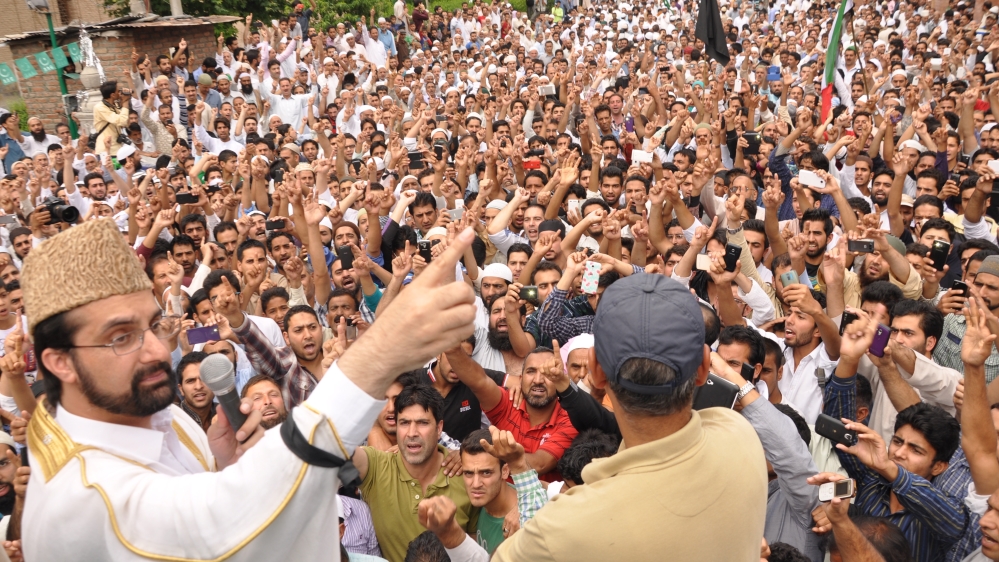 |
The separatists
The movement that does call for Kashmiris' right to self-determination through a plebiscite is the separatist All Parties Hurriyat Conference - an alliance of political groups formed in 1993. Hurriyat is widely supported by Kashmiris, but has never been part of a government because it doesn't contest elections, saying it won't recognise the Indian constitution's rights over Kashmir.
Mirwaiz Umar Farooq is the head of the Awami Action faction of Hurriyat. Farooq, who had been confined to his Srinagar house since July 8, was arrested on Friday. Separatist leaders such as Farooq are often put under house arrest in an effort to keep them away from their supporters.
Speaking on the phone from his home in Srinagar, Farooq says: "The government of India does not want to acknowledge Kashmir as a political problem because if they do that, they are on a weaker wicket because India's political case is very weak. That's why the government says it's terrorism, it's extremism, it's Islamic fundamentalism."
"Maybe the government is much more comfortable dealing with an armed resistance rather than a peaceful resistance. They don't have 600,000 troops to fight the 100 militants. They have troops to fight the people because that's where the real power is," he adds.
Despite Hurriyat's popularity, Kashmiris largely ignored its call for a boycott of the 2014 state elections and turned out in record numbers to vote. The PDP-BJP coalition says this is proof that Kashmiris support their alternative of 'dialogue' over the separatists' call for a referendum. Hurriyat says elections are only for administrative purposes, and don't address the root of political problems.
"When people vote in elections, this is a vote for day-to-day issues - infrastructure, roads, water, electricity, hospitals. It is never a vote for India," Farooq says.
When asked why Hurriyat doesn't contest elections instead of calling for protests and strikes, Farooq answers, "If there's an election under the ambit of the Indian constitution where the only aim is to form a government that will ratify India's claims on Kashmir, obviously Hurriyat has a problem with that because we have always maintained that our position on Kashmir is, it's a dispute. Even the UN resolutions are very clear - that no election in Kashmir can be a substitute for self determination."
Where the government and Hurriyat agree is their fear that things will only get worse.
The PDP had traditionally been the defender of human rights in Kashmir. It had, according to Akhter, "galvanised those people who were living in the grey space - who believed in peaceful methods, but who did not believe in the constitution".
But as the death toll and injuries have climbed, the PDP's popularity seems to have declined.
"Our worry is the people who have come back to the mainstream, who had developed a stake in the democratic system, they should not go back into the same whirlpool, where from their retrieval will become more difficult," Akhter says.
Farooq reflects: "In the 90s when the movement started, in 2000, there was anger, there was alienation among the youth, but today's generation, there is absolute hate vis-à-vis India and that is something which is pushing the youth towards extremes. Every Kashmiri identifies himself with the story of Burhan because every Kashmiri boy or young man has suffered at the hands of Indian security forces."
"So in that context, a new generation of these young, educated boys are being pushed against the wall, pushed to take up the gun, to take up violence once again, which obviously we don't want."
The Indian army may have all but crushed the armed rebellion, but the cries of ordinary Kashmiris are now louder than ever.

